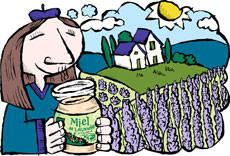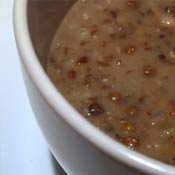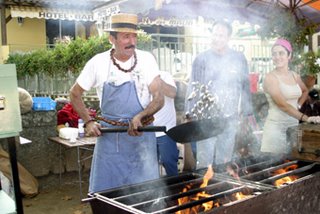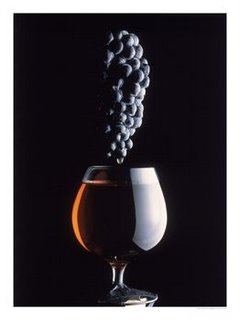Honey of Provence

Labels: bee keeping, heather honey, honey, lavender honey, sweet chestnut honey
All about 16 towns and villages in the Gulf of St Tropez and much else besides. Too much of a good thing indeed ...

Labels: bee keeping, heather honey, honey, lavender honey, sweet chestnut honey
 Roasted Chestnut and Lentil Soup
Roasted Chestnut and Lentil SoupLovely! Any more great chestnut recipes out there? Please use the 'Add Comment' tag below to share ..............
Labels: bread, celery, chestnuts, honey, lentils, onion, soup
 The sweet chestnut tree is prevalent in the wooded slopes near some of our villages. These trees can live for several centuries and reach 35 metres high . A spiky, prickly husk protects the actual fruit - the chestnut - which is rich in starch and is a highly valued crop.
The sweet chestnut tree is prevalent in the wooded slopes near some of our villages. These trees can live for several centuries and reach 35 metres high . A spiky, prickly husk protects the actual fruit - the chestnut - which is rich in starch and is a highly valued crop.Labels: chataigne, chestnuts, Collobrières
 Well, we went away for a week and it's taken me almost another week to get back into a routine - hence the gaps in what is supposed to be a daily blog! We - myself, my daughter and 3 dogs, Dilys, Hettie and Harvey stayed near Chateauvert which is about an hour by road inland from my usual haunts. It is a quiet and sheltered spot. At night there is no light pollution - it is years since I've been in real, natural darkness and I loved it. My daughter slept for most of the first two days - after a long, hard summer season as a holiday village receptionist followed by the end of season parties and piss-ups, she was in need of a little R and R. We festered in front of DVDs and ate rather a lot.
Well, we went away for a week and it's taken me almost another week to get back into a routine - hence the gaps in what is supposed to be a daily blog! We - myself, my daughter and 3 dogs, Dilys, Hettie and Harvey stayed near Chateauvert which is about an hour by road inland from my usual haunts. It is a quiet and sheltered spot. At night there is no light pollution - it is years since I've been in real, natural darkness and I loved it. My daughter slept for most of the first two days - after a long, hard summer season as a holiday village receptionist followed by the end of season parties and piss-ups, she was in need of a little R and R. We festered in front of DVDs and ate rather a lot.Labels: Barjols, Brignoles, Chateauvert, dogs, dvds, exploring, Le Val, museum, walks, waterfall
Labels: promenade, Ramatuelle, tourist, walk
 The name Cavalaire comes from the Greek colony "Heraclea Cacabaria" which founded a settlement in the bay. It evokes memories of Carthage and Hercules. The story of this young town (which has just celebrated its 70th birthday) of 5300 inhabitants began in 800 B.C. when the Ligurians occupied the fortress of Montjean. The Count of Provence, Guillaume I, built a watchtower on Cap Cavalaire, which was subsequently fortified by the Counts of Grimaud. the fortifications were destroyed in 1646.
The name Cavalaire comes from the Greek colony "Heraclea Cacabaria" which founded a settlement in the bay. It evokes memories of Carthage and Hercules. The story of this young town (which has just celebrated its 70th birthday) of 5300 inhabitants began in 800 B.C. when the Ligurians occupied the fortress of Montjean. The Count of Provence, Guillaume I, built a watchtower on Cap Cavalaire, which was subsequently fortified by the Counts of Grimaud. the fortifications were destroyed in 1646.In the 18th century, Cavalaire was a small fishing village, attached to the neighbouring village of Gassin until 1929. On August 15, 1944, the Allied Forces chose the site for the landings of the American army's 3rd infantry division. Cavalaire's main activity is now tourism and the town possesses a 1200 berth marina, famous throughout the Mediterranean. The remains of the Ligurian fortress, inhabited from 6 to 4 B.C., can still be admired on the heights overlooking Cavalaire Bay.
 Le nom de Cavalaire provient d'une colonie grecque "Heraclea Cacabaria" qui avait pris position dans le baie. Il évoque le souvenir de Carthage et rapelle le culte d'Hercule. L'histoire de cette jeune commune (elle vient de fêter ses 70 ans) de 5300 habitants commence 800 ans avant notre ère avec les Ligures, installés dans leur oppidum (forteresse) du Montjean. Le compte de Provence, Guillaume Ier, construisit sur le Cap Cavalaire une tour de vigie à laquelle les comtes de Grimaud ajoutèrent des fortifications, détruites en 1646.
Le nom de Cavalaire provient d'une colonie grecque "Heraclea Cacabaria" qui avait pris position dans le baie. Il évoque le souvenir de Carthage et rapelle le culte d'Hercule. L'histoire de cette jeune commune (elle vient de fêter ses 70 ans) de 5300 habitants commence 800 ans avant notre ère avec les Ligures, installés dans leur oppidum (forteresse) du Montjean. Le compte de Provence, Guillaume Ier, construisit sur le Cap Cavalaire une tour de vigie à laquelle les comtes de Grimaud ajoutèrent des fortifications, détruites en 1646.

The harvest of 2006 will be lower than last year’s because of the drought. Less grapes have been produced but are very healthy with a good overall quality. The forecast is for a total production in the region of 7000 to 8000 hectoliters compared with 10000 in 2005.
The wine cooperative of St Tropez gathers crops from 174 producers with a total of 200 hectares ranging in size from small garden vineyards to fields of 25 ha. The grapes poured into the reception area throughout last week and went through the traditional cycle: weighing, pressing in the pneumatic stainless steel pneumatic press (capacity 80 hectoliters), settling in the decantation tanks (cap: 250 hectoliters) and finally ending up in the vats for the fermentation process to begin.